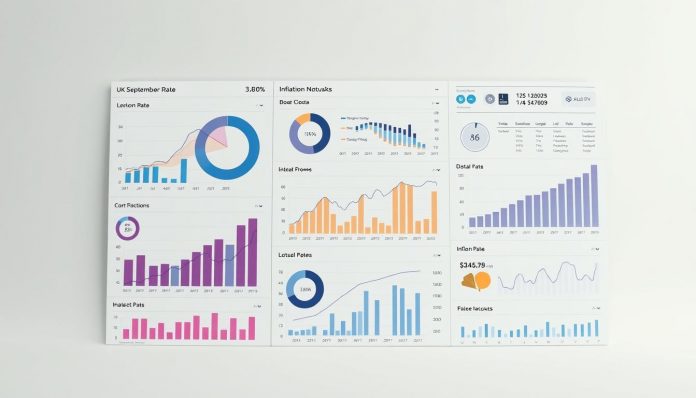What if the most important economic news this month wasn’t about change, but about stability in the UK economy news? While many expected prices to surge further, the latest figures tell a different story.
Official data shows the inflation rate steady at 3.8% for three months, defying predictions of a rise to 4%, despite concerns about expected inflation trends in the coming years.
This stability offers relief to households, but economists warn of ongoing pressures in goods and services, especially as we look ahead to UK inflation 2025.
The rate is nearly double the Bank of England’s target, posing challenges for policymakers and consumers.
Key Takeaways
- Inflation remained unchanged for three months
- Stability surprised analysts expecting an increase
- Households get temporary relief from costs
- The figure is above the central bank’s target
- Pressures in services and housing persist
- Experts see mixed signals for policy decisions
- Consumers face ongoing challenges despite the positive news
Introduction: A Welcome Hold Amidst Economic Anxiety
Amidst forecasts of an increase, the latest figures brought an unexpected pause in rising prices, offering collective relief across Britain’s economy.
Households, the government, and the Bank of England share this reprieve, as many expected the figure to reach 4%, adding pressure on budgets. The result is a temporary stabilisation in consumer costs, although questions remain about future trends.
However, this stability exists against a backdrop where the rate is nearly double the Bank of England’s target of 2%, raising concerns about whether we are nearing a peak in inflation.
Consumer confidence reflects recent traumatic price rises, with many recalling a spike that compressed a decade’s increases into two years. As we look towards UK inflation September 2025, the implications of these figures will be critical.
“The psychological impact of previous inflationary periods continues to influence spending behaviour,” economists note.
This creates challenges for the economy; despite positive news, many consumers remain cautious.
Chancellor Rachel Reeves faces pressure as the Autumn Budget approaches, with above-target inflation complicating fiscal planning.
This month’s data sets a tone for monetary policy decisions, influencing expectations around interest rates and support measures.
The mixed reactions among stakeholders highlight the situation’s complexity; while some celebrate stability, others emphasise ongoing pressures.
This context of economic anxiety forms the background for understanding current conditions. The following sections will explore the specific data and implications in greater detail.
For the BBC’s full analysis of the September figures, read their latest report here.
September UK Inflation Remains at 3.8%: Key Analysis
Breaking Down the ONS Data
A closer look at the Consumer Prices Index and the latest ONS inflation data shows mixed signals. The Office for National Statistics reveals both encouraging trends and challenges.
Headline CPI: Stability Against Forecasts of a Rise
The Consumer Prices Index held steady at 3.8% for the year to September, surprising analysts who predicted a rise to 4%.
This unchanged figure indicates economic resilience and potential shifts in consumer spending.
Food Price Deflation: A Glimmer of Relief for Households
Food prices decreased, offering relief, with staples like vegetables and bread seeing reductions.
This trend helps ease cost of living pressures and benefits household budgets.
Stubborn Services Inflation: The Core of the Persistent Challenge
Services inflation remained at 4.7%, a significant challenge for policymakers.
Transport costs rose from 2.4% to 3.8%, adding pressure to overall inflation.
The persistence of service inflation reflects ongoing labour market and production cost pressures.
Economists see this sector as crucial for future trends. The Bank of England will monitor these figures for interest rates.
Inflation Holds — But Still Above the Bank of England’s 2% Target
Policymakers face a balancing act as inflation remains above their comfort zone. The 3.8% figure is nearly double the ideal target.
This gap poses challenges for the Bank of England in achieving price stability. Officials must weigh the risks of aggressive action against prolonged high inflation.
Consumer psychology is affected by this sustained elevation. Many households feel jittery about spending despite recent stability.
This cautious approach influences economic activity. High inflation affects sectors differently.
“When inflation remains elevated, it changes how people think about money,” notes one economist.
The situation compares interestingly with other major economies. Among G7 nations, Britain’s position reflects shared global pressures and unique domestic factors.
Returning to the 2% target may require patience. Previous stubborn inflation episodes show the process often takes longer than expected.
For savers and investors, this environment creates challenges. Long-term planning becomes complex when price rises outpace safe returns.
According to recent analysis, core inflation excluding volatile components stood at 3.5%, providing insight into price pressures.
Chancellor Rachel Reeves must consider these factors ahead of the Autumn Budget. Fiscal policy must complement monetary efforts to control inflation.
Most experts view the current level as transitional rather than a new normal. However, the timeline for returning to the target remains uncertain due to ongoing pressures.
The path forward depends on factors like global energy costs and domestic wage settlements. The Bank of England will monitor these closely for future interest rate decisions.
Services Inflation and Labour Costs: Why Prices Remain Sticky
Service sector pricing faces persistent challenges. Some categories improve, but many resist change.
This stickiness complicates policymaking, indicating deeper structural issues beyond temporary fluctuations.
The Link Between Wage Growth and Service Sector Prices
Wage increases of nearly 5% directly impact service costs, with businesses passing higher labour expenses to consumers.
This creates a cycle for the economy, limiting options for service providers facing rising costs.
The link is strongest in labour-intensive sectors like hospitality and healthcare, which are sensitive to wage pressures.
Analyst Views on Entrenched Inflationary Pressures
Experts worry about embedded inflation; structural factors hinder price adjustments in many services, contributing to the rising UK cost of living 2025.
Productivity challenges worsen these issues across industries, leading to persistently higher prices, further exacerbating the cost of living.
| Factor | Impact Level | Primary Affected Sectors |
|---|---|---|
| Public sector pay settlements | High | Healthcare, education, and administration |
| Skills shortages | Medium-High | Technology, construction, professional services |
| Labour mobility restrictions | Medium | Hospitality, retail, care services |
| Demographic changes | Medium | All service sectors |
Regional variations complicate the national picture, with some areas seeing stronger wage growth and price rises.
Hotels and restaurants face significant inflationary pressures from labour costs and other input increases.
“The persistence of services inflation suggests we’re dealing with more than temporary factors. Structural issues in the labour market and productivity need addressing.”
These patterns could influence long-term consumer behavior, as households may adjust spending if service costs stay high.
The Bank of England closely monitors these developments regarding interest rates. Service sector inflation is key for monetary policy decisions.
Chancellor Rachel Reeves must consider these factors ahead of the autumn budget, as fiscal measures could alleviate or worsen these pressures.
Bank of England Interest Rates: What the Hold Means for Monetary Policy
Monetary authorities face complex decisions as price stability remains elusive. Elevated inflation complicates policy adjustments.
Current data suggests careful consideration before changes. The central bank must balance competing priorities.
The MPC’s Cautious Stance on Future Rate Cuts
The Monetary Policy Committee takes a measured approach to reductions. Clear evidence of improvement is needed before changes.
With inflation nearly double the target, premature action could undermine progress. The committee emphasises data-driven decisions.
Recent statements express concerns about inflationary pressures, especially in services.
Market Expectations and the Path for Borrowing Costs
Financial markets anticipate adjustments next year despite current conditions, differing from official guidance.
Analysts project two possible base rate reductions in 2026, assuming a gradual improvement in price stability.
However, predictions depend on economic developments; unexpected data shifts could alter expectations.
The path for borrowing costs relies on various factors, including global conditions and wage settlements.
Households and businesses face uncertainty about financing costs, affecting spending and investment.
“The Bank’s cautious approach reflects lessons from past inflationary episodes. Premature relaxation could necessitate sharper corrections later.”
International comparisons show varied approaches among central banks facing persistent price pressures.
The Bank of England’s stance aligns with cautious global trends. Most economies monitor inflationary risks closely.
Chancellor Rachel Reeves must consider these monetary constraints for the autumn budget.
Fiscal measures should complement monetary efforts for economic stability.
Different sectors experience varied impacts from maintained rates, with housing and consumer credit under pressure.
Investment decisions reflect financing costs, influencing expansion and hiring.
The Monetary Policy Committee’s November meeting will provide clarity. Markets await updated assessments.
Experts suggest patience rather than rapid policy shifts. Gradual adjustments are typically more sustainable.
To explore the wider context, see our recent article, 2025 Inflation Target: Is It Still Relevant? What You Need to Know.
What This Means for UK Businesses: Navigating High Costs
British companies face a complex landscape balancing rising expenses with cautious consumer spending, especially in light of the UK economic outlook. Elevated price pressures create significant challenges across sectors.
Manufacturers report strain with factory gate prices climbing to 3.4%, reflecting growing input costs that businesses must absorb or pass along.

Firms find themselves caught between rising operational expenses and hesitant customers, requiring careful strategic planning.
Rising Business Costs and UK Manufacturing Inflation
Production expenses have steadily increased over the past year, driven by raw material costs, energy bills, and transportation fees, contributing to rising UK business costs.
The manufacturing sector shows vulnerability to these pressures, with factory output prices rising significantly compared to last year, which is a reflection of ongoing rate inflation.
Labour expenses also add to operational overheads, affecting final consumer prices. Businesses must decide whether to absorb these costs or adjust pricing.
“When business costs rise consistently, companies face difficult choices about pricing, investment, and sustainability.”
Supply chain disruptions continue to affect many industries, compounding existing cost pressures for British businesses.
Consumer Jitters and the Impact on Demand
Household spending has shifted recently, with shoppers becoming more selective.
This cautious approach affects retail and service sectors, as customers prioritise essential goods over discretionary spending.
The impact of previous price rises still influences shopping behavior, leaving consumers wary despite recent stability in the overall rate.
Business revenue faces pressure from reduced consumer confidence, with many companies reporting slower sales growth.
This environment poses challenges for smaller enterprises, which struggle to absorb rising costs without adjusting prices.
The upcoming autumn budget will be closely watched by leaders hoping for measures to ease cost pressures.
Rachel Reeves faces tough decisions on supporting businesses while managing inflation risks, impacting the commercial landscape.
Despite challenges, some businesses find innovative ways to manage costs, using efficiency improvements to mitigate pressure.
The path ahead requires careful navigation of economic conditions and consumer sentiment. Businesses must adapt to this complex environment.
The Mortgage Market: Relief and Uncertainty for Borrowers
Britain’s property landscape presents a complex picture for homeowners and buyers. The latest economic data offers reassurance and challenges in housing finance.
Mortgage costs have edged up slightly, but the trend is more favorable than last year.
Affordability has improved due to five base rate reductions since last August.
Lenders have relaxed stress testing, making it easier for buyers to qualify for mortgages.
Sellers are more competitive, creating better opportunities despite economic pressures.
Recent Trends in Mortgage Rate Pricing
Financial institutions have adjusted offerings in response to economic signals. Steady inflation has influenced pricing strategies.
Fixed-rate deals have seen modest increases, reflecting cautious optimism among lenders.
The Bank of England’s stance on interest rates provides stability, but lenders watch for changes in monetary policy.
Regional variations show different lending conditions; London has higher costs, while northern regions offer attractive products.
Advice for Homeowners and First-Time Buyers
About 750,000 borrowers face renewals in six months and should secure deals sooner.
Experts suggest reviewing options three to six months before renewal dates.
First-time buyers should explore lender criteria and government schemes for favorable terms.
Mortgage advisors recommend considering both short- and long-term plans, as fixed-rate deals provide certainty.
The autumn budget adds consideration; changes to taxes may influence timing. Buyers should monitor Treasury announcements.
Professional advice is valuable in navigating these decisions. Independent brokers can access various products.
The UK Cost of Living in 2025: Households Feel the Squeeze
While the headline figure suggests stability, many families face a different reality. Three years of price increases have stretched household budgets thin.
Official statistics often mask daily struggles. Sustained higher costs have created financial pressure for millions.
Chancellor Rachel Reeves acknowledges this challenge and suggests further support may come in the autumn budget.
Beyond the Headline Rate: The Real-World Impact
Essential spending categories show significant upward pressure. Food, energy, and housing costs remain pain points for families.
Regional variations mean some areas feel the squeeze more than others, with northern households facing different challenges.
Different demographic groups experience varying impacts, with pensioners and low-income families feeling price rises more acutely.
Many households have developed coping strategies, including budgeting adjustments and reduced discretionary spending.
“The official measure doesn’t always capture the full picture of household expenditure. Many families experience inflation differently from the headline rate.”
Previous government support provided temporary relief, but many households feel ongoing challenges remain unaddressed.
The persistence of high costs has changed long-term spending patterns and consumer expectations.
The Chancellor’s Hint at Energy Bill Relief
Energy costs are a major concern for households. Despite some price drops, many still face high bills.
The chancellor hinted at possible targeted support in November’s budget for energy affordability.
Previous help was short-term, but many seek more structural long-term solutions.
Experts suggest potential measures like direct bill support, energy efficiency programs, or supplier regulation.
| Support Measure | Potential Impact | Implementation Timeline |
|---|---|---|
| Direct bill support | High immediate relief | Winter 2025 |
| Energy efficiency grants | Medium-long-term savings | 2026 rollout |
| Supplier price caps | Medium consumer protection | Consultation required |
| Green energy incentives | Long-term transformation | Multi-year programme |
The Bank of England will monitor fiscal interventions closely to avoid fueling inflation.
Interest rate decisions are sensitive to these issues, balancing household struggles with economic stability.
Looking ahead, household finances will remain tough, but experts expect a gradual easing of cost pressures next year.
However, the impact of the past three years will linger, necessitating continued support for families rebuilding resilience.
The Autumn Budget Looms: Chancellor Reeves’s Difficult Choices
Chancellor Rachel Reeves faces a fiscal crossroads as the autumn budget approaches. Elevated inflation complicates her goal of supporting working people while maintaining stability.
Government borrowing costs have risen sharply due to price pressures, constraining policy options.

Debt accumulation has reached its fastest pace in five years, forcing tough decisions on revenue and expenditure.
Speculation on Tax Reforms and Fiscal Measures
Observers anticipate tax adjustments in the announcement. The chancellor must balance revenue needs with growth concerns.
Various policy areas are under consideration, including energy support and benefit adjustments.
Public sector pay settlements are also challenging, impacting household finances and government expenditure.
International comparisons show different approaches to similar challenges, with some nations implementing targeted support while others focus on deficit reduction.
Balancing Support with Inflationary Risks
The chancellor must balance relief with avoiding price pressures, requiring careful policy design.
Previous aid provided temporary help but raised inflation concerns for the Bank of England.
“Fiscal policy must support monetary efforts. Poorly designed aid could hinder inflation control.”
Interest rate decisions significantly influence budgets. Higher borrowing costs limit policy options.
The current inflation rate is nearly double the central bank’s target, affecting monetary policy.
Long-term economic stability is crucial; today’s budget choices will impact future conditions.
Rachel Reeves’s decisions will reflect her economic philosophy and test her ability to meet promises.
Conclusion: September UK Inflation Remains at 3.8%: Key Analysis
Navigating a Period of Stubborn Inflation
The steady price measure offers cautious optimism after recent economic turbulence. Markets welcome this stability as evidence that gradual control is being achieved.
However, the current level remains nearly double the Bank of England target. This creates ongoing challenges for policymakers and households alike.
Services sector costs continue presenting the most stubborn resistance to improvement. Labour market pressures and wage growth sustain these elevated levels.
Chancellor Rachel Reeves faces difficult decisions in the upcoming autumn budget. Her choices must balance support measures against inflationary risks.
Most experts anticipate gradual improvement throughout next year. The path forward requires careful navigation between stability hopes and stagnation concerns.


